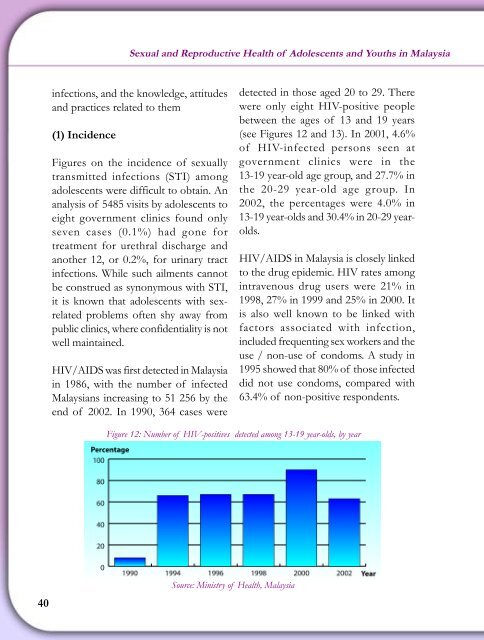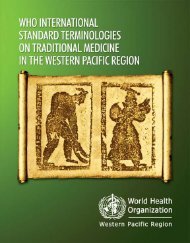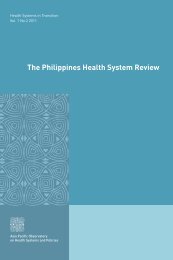Download pdf, 989kb - WHO Western Pacific Region - World Health ...
Download pdf, 989kb - WHO Western Pacific Region - World Health ...
Download pdf, 989kb - WHO Western Pacific Region - World Health ...
You also want an ePaper? Increase the reach of your titles
YUMPU automatically turns print PDFs into web optimized ePapers that Google loves.
Sexual and Reproductive <strong>Health</strong> of Adolescents and Youths in Malaysia<br />
infections, and the knowledge, attitudes<br />
and practices related to them<br />
(1) Incidence<br />
Figures on the incidence of sexually<br />
transmitted infections (STI) among<br />
adolescents were difficult to obtain. An<br />
analysis of 5485 visits by adolescents to<br />
eight government clinics found only<br />
seven cases (0.1%) had gone for<br />
treatment for urethral discharge and<br />
another 12, or 0.2%, for urinary tract<br />
infections. While such ailments cannot<br />
be construed as synonymous with STI,<br />
it is known that adolescents with sexrelated<br />
problems often shy away from<br />
public clinics, where confidentiality is not<br />
well maintained.<br />
HIV/AIDS was first detected in Malaysia<br />
in 1986, with the number of infected<br />
Malaysians increasing to 51 256 by the<br />
end of 2002. In 1990, 364 cases were<br />
detected in those aged 20 to 29. There<br />
were only eight HIV-positive people<br />
between the ages of 13 and 19 years<br />
(see Figures 12 and 13). In 2001, 4.6%<br />
of HIV-infected persons seen at<br />
government clinics were in the<br />
13-19 year-old age group, and 27.7% in<br />
the 20-29 year-old age group. In<br />
2002, the percentages were 4.0% in<br />
13-19 year-olds and 30.4% in 20-29 yearolds.<br />
HIV/AIDS in Malaysia is closely linked<br />
to the drug epidemic. HIV rates among<br />
intravenous drug users were 21% in<br />
1998, 27% in 1999 and 25% in 2000. It<br />
is also well known to be linked with<br />
factors associated with infection,<br />
included frequenting sex workers and the<br />
use / non-use of condoms. A study in<br />
1995 showed that 80% of those infected<br />
did not use condoms, compared with<br />
63.4% of non-positive respondents.<br />
Figure 12: Number of HIV-positives detected among 13-19 year-olds, by year<br />
40<br />
Source: Ministry of <strong>Health</strong>, Malaysia

















